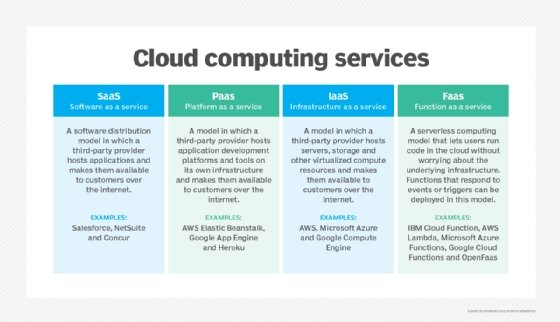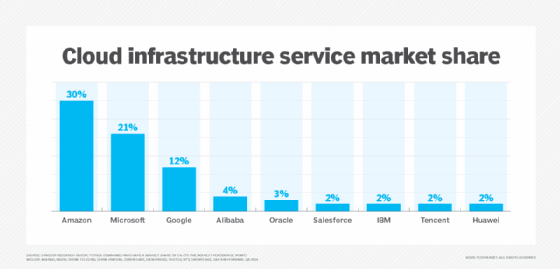Top public cloud service providers of 2025: How they compare
As the market share gap tightens among AWS, Microsoft and Google, see how their features and offerings stack up against each other and some of the smaller cloud providers.
The public cloud marketplace consists of numerous cloud infrastructure service providers. Amazon Web Services, Microsoft Azure and Google Cloud collectively account for more than 60% of the cloud market, which includes IaaS, PaaS and hosted cloud services. The remaining public cloud market is divided among several smaller providers, including Alibaba Cloud, Oracle Cloud, Salesforce, IBM Cloud and Tencent Cloud, according to Synergy Research Group data.
Big 3 cloud service providers
Amazon Web Services
AWS is the cloud service provider (CSP) leader, owning about 30% of the market. The AWS cloud consists of more than 200 services, providing on-demand cloud computing platforms and APIs.
Service-level agreement. Amazon doesn't provide a standardized uptime commitment or service-level agreement (SLA) across the entire AWS cloud. Instead, it provides SLAs for each service. In the case of the EC2 platform for hosting VM instances, Amazon offers a regional-level SLA of 99.99% uptime and an instance-level SLA of 99.5%. The company provides a tiered system of service credits. The service credit percentage is tied to the duration of an outage, with longer outages eligible for larger credits.
Regions and zones. One of the more important considerations when evaluating a CSP is the number of global regions and availability zones offered. Amazon currently consists of 34 regions around the globe and has a total of 108 availability zones.
Interface. Another important factor when selecting a public cloud is the options for interacting with cloud resources. CSPs, such as Amazon, Microsoft and Google, make SDKs available to developers so applications can more easily use cloud resources. From an administrative standpoint, CSPs offer a web portal and CLI. AWS Command Line Interface can be installed on Windows, macOS or Linux. Amazon also offers a PowerShell version of its Command Line Interface.
Pricing. Amazon uses a pay-as-you-go (PAYG) model for its AWS cloud resources. The formulas used to calculate usage costs are complex, but Amazon offers a pricing calculator that can help determine overall costs. Amazon also makes some of its cloud resources available in a free tier. These resources aren't generally suitable for running production workloads, but can help understand how the various Amazon services work without making a big investment.

Microsoft Azure
Microsoft Azure is the second-largest cloud service with more than 200 products and services to build, run and manage applications.
SLA. Microsoft has a separate SLA for each service within its Azure cloud. The company's uptime guarantee for Azure VMs is similar to Amazon's SLA for EC2 instances. VMs consisting of at least two instances and deployed across two availability zones are guaranteed to have 99.99% uptime, which drops to 99.95% if the instances are in the same availability zone. The SLA for single-instance VMs varies depending on the hardware configuration, but all VMs are guaranteed to have at least 95% uptime. Microsoft, like Amazon, offers credits when SLAs aren't met.
Regions and zones. Microsoft maintains numerous regions and availability zones in the Azure cloud. These availability zones are separate data centers in a region, with roundtrip latency in the region of less than 2 milliseconds. Microsoft currently offers 27 regions that each support multiple availability zones. In total, there are 64 regions and 126 availability zones.
Interface. The Microsoft Azure portal is relatively easy to navigate. Most Azure services and resources can be managed from within the portal without delving into the command-line environment. For users preferring a command-line environment, Microsoft offers an Azure CLI, which can be installed on Windows, Linux or macOS and uses Linux-style commands. There's also an option to run the Azure CLI in Docker or Azure Cloud Shell. Microsoft also offers Azure PowerShell, which is essentially a PowerShell module that can be used to manage Azure resources from a PowerShell session.
Pricing. Microsoft Azure pricing varies widely based on the services used and the region in which the services are hosted. Microsoft provides a pricing calculator to estimate the cost of running various workloads on Azure. For new Azure users, Microsoft offers a 30-day free trial, which includes a $200 credit that can be used on Azure services.
Google Cloud
Google Cloud is the third-largest cloud platform, providing a series of modular cloud services and management of computing, data storage, data analytics and machine learning applications.
SLA. Google ties its SLAs to specific services. In the case of Google's Compute Engine, the SLA varies based on tier. A single instance in the Premium Tier is guaranteed to have an uptime of at least 99.9%. Uptime guarantees increase to 99.99% for instances in multiple zones. Google also offers a financial credit when it fails to meet its SLA.
Regions and zones. Google has an impressive number of data centers in North America, South America, Europe, the Middle East and Asia-Pacific -- collectively accounting for the company's 41 regions and 124 availability zones. In North America, there are roughly 36 availability zones.
Interface. The primary method of interacting with Google Cloud is through its web portal. Google offers a command-line environment known as gcloud CLI, which supports Linux-style commands and can be installed on Linux, macOS and Windows.
Pricing. Google offers the same type of PAYG pricing as other providers. Users can receive up to $300 in free credits and access to more than 20 products within Google Cloud. Because cloud pricing tends to be complex, Google provides a pricing calculator to estimate the cost of running various workloads in its cloud.

5 smaller cloud providers
Alibaba Cloud
The largest cloud provider in China, Alibaba Cloud offers nearly 200 cloud computing products and services for online business and Alibaba's own e-commerce ecosystem.
SLA. Alibaba offers different SLAs for each of its services. SLAs can often vary based on how the service is configured. For its Elastic Compute Service (ECS) for hosting VM instances in the cloud, Alibaba offers a monthly SLA of 99.975% uptime for single instances and 99.995% for multizone instances.
Regions and zones. Alibaba Cloud currently supports 85 availability zones spread across 28 regions. Many of Alibaba's data centers are located in mainland China, but the company operates data centers in the U.S. and other locations.
Interface. Alibaba Cloud includes a web interface. Other options for interacting with Alibaba Cloud include its open source CLI; Cloud Client, which can be installed on Windows or macOS; and Cloud Shell, which is a web-based command-line tool.
Pricing. Alibaba's PAYG pricing model is similar to other CSPs. The company also offers subscription-based billing as an alternative to traditional consumption-based pricing. It provides a pricing calculator to help users determine their overall costs. Alibaba offers a free trial for new users, providing access to more than 50 products and free access to ECS for 12 months.
IBM Cloud
Although IBM Cloud might best be described as an IaaS service, Big Blue also offers PaaS and containers as a service within its cloud. IBM Cloud consists of more than 230 products and services.
SLA. IBM offers four different tiers of service, with SLAs for the various tiers ranging from 99.9% to 99.995% uptime. Most of the services within IBM Cloud are offered in one or more tiers. VMware as a service, for example, is tied to Tier 1 (99.9%) for single-instance configuration and Tier 3 (99.99%) for workloads distributed across three or more instances in separate availability zones.
Regions and zones. IBM Cloud currently spans 10 regions across North and South America, Europe and Asia-Pacific. There are 31 availability zones within these regions.
Interface. IBM has created the IBM Cloud console as the primary tool for interacting with IBM Cloud. There's also an IBM Cloud CLI to manage IBM Cloud from the command line, whose interface can be installed on Windows, macOS and Linux systems.
Pricing. IBM offers PAYG and subscription-based pricing similar to Alibaba Cloud. Other options include cloud savings and reservation plans. IBM provides a cost estimator. The company offers a free trial for IBM Cloud, which includes a $200 credit and provides access to more than 40 services within IBM Cloud and access to over 350 different products.
Oracle Cloud Infrastructure
Oracle Cloud Infrastructure (OCI) consists of IaaS and PaaS and encompasses more than 100 offerings, including VMware, containers and AI-related services.
SLA. Oracle has created a variety of SLAs covering areas such as availability, manageability and performance. Individual SLAs are listed in accompanying documentation. Oracle Cloud VMware Solution, for example, has a financially backed availability SLA of 99.95%.
Regions and zones. Oracle currently supports 50 regions globally, with plans for roughly two dozen additional regions.
Interface. Oracle has created a web-based dashboard to navigate OCI. Users can also interact with OCI using a CLI. Additionally, Oracle offers a call interface for developers.
Pricing. Oracle uses consumption-based pricing for its cloud services, with unique pricing for each service. Oracle claims in its estimator that its pricing is "50% less for compute, 70% less for block storage, 80% less for networking" than Amazon, Microsoft and Google pricing.

Salesforce Service Cloud
Salesforce is not an IaaS provider, but it does own significant cloud market share. The company provides cloud-based CRM software -- Salesforce Service Cloud -- that tracks interactions with customers, manages customer data, automates processes and analyzes data.
SLA. Salesforce provides users with a financially backed service availability SLA that guarantees service uptime of 99.99% per month. Salesforce credits users if the monthly availability drops below 99.95%. Credits are calculated based on a percentage of the user's subscription cost, and the percentage increases as availability decreases. The maximum credit that customers can receive is 15% if availability drops below 98%.
Regions and zones. Salesforce operates data centers in 10 metropolitan areas to provide redundancy. If a service disruption occurs, workloads can be transitioned to another region.
Pricing. Salesforce offers 14 different cloud-based products, each with its own unique pricing. The company also offers multiple pricing tiers for most of its products and services. Pricing is usually based on a per-user, per-month basis.
Tencent Cloud
An IaaS cloud provider based in Shenzhen, China, Tencent Cloud offers about 165 products and services within its cloud, ranging from streaming media to compute and container services.
SLA. Tencent Cloud offers a financially backed SLA with the service level varying depending on the service. The SLA for a single instance within the Cloud Virtual Machine service, for example, is 99.975% uptime. This level of service increases to 99.995% for workloads that use multiple availability zones.
Regions and zones. Tencent Cloud consists of 21 regions and 58 availability zones. Nearly all the company's regions are in Asia, including seven in China. The company has two regions in North America, one in Europe and one in South America.
Interface. Tencent Cloud offers a web portal and a CLI, which can be installed on Windows, macOS and Linux systems and requires the Python 2.7 programming language or higher.
Pricing. Tencent Cloud offers three pricing models -- PAYG, monthly and annual subscription, and tiered. The company provides a cost calculator to estimate workload costs and offers a free trial based on individual services. A free trial for one package, for example, might be valid for one year and include up to 10 GB of data, while another package could be valid for just six months but allow up to 50 GB of standard storage.
Editor's note: This article was updated in December 2024 to reflect the latest developments and provide readers with a more expansive view of the cloud provider options.
Brien Posey is a 15-time Microsoft MVP with two decades of IT experience. He has served as a lead network engineer for the U.S. Department of Defense and as a network administrator for some of the largest insurance companies in America.







